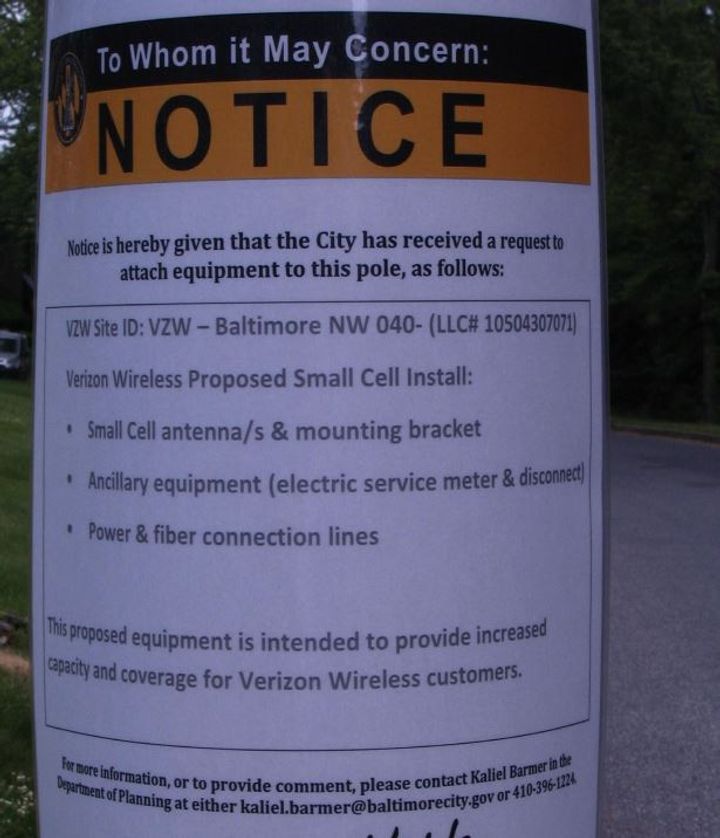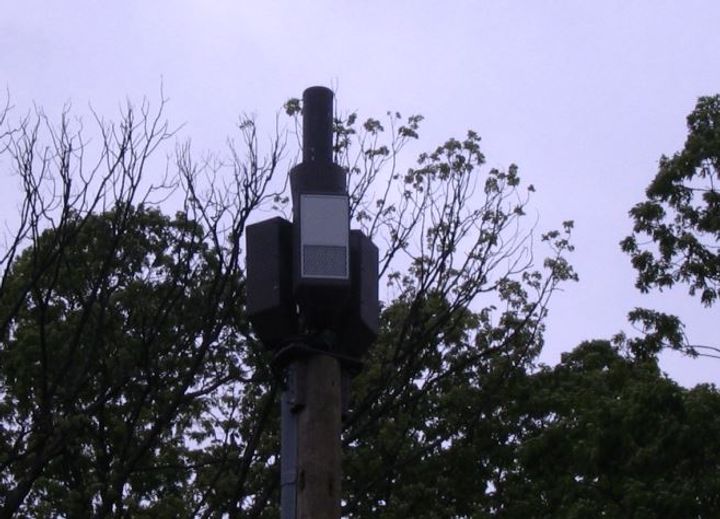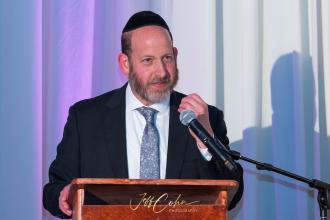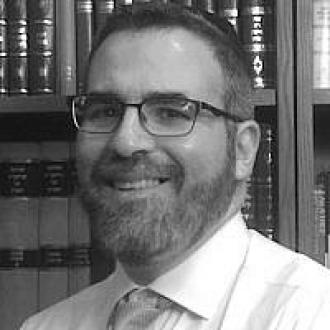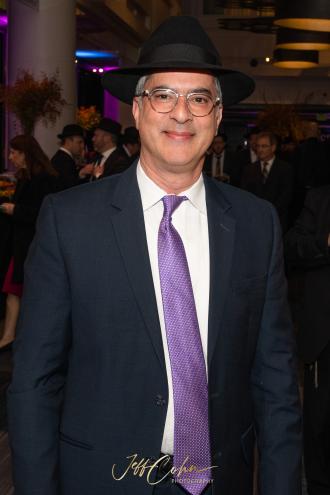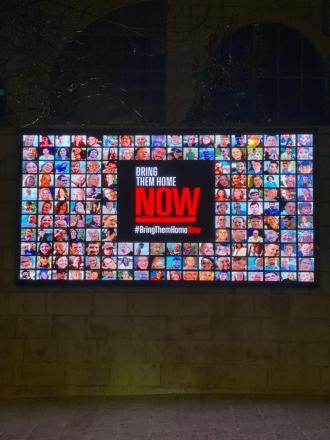Baltimore, MD - July 6, 2020 - Verizon’s attempts to place cell towers in the Baltimore Jewish community has touched off a storm of protest. Some of these towers have already been installed, while others are on the way. This is part of Verizon’s 5G rollout that promises to bring better live streaming of TV and movies, enable driverless cars and improve cell phone reception. AT&T as well as a smaller company named Crown Castle are also installing 5G cell towers in Baltimore City.
Much of the recent concern about Verizon’s cell towers is focused on three of the planned towers for the Jewish community. The proposed locations are: 3300 Pinkney Road, 5991 Western Run Drive, and 2509 Wetherburn Road. Comments were due to the city planners on June 26th. In response to this invitation to comment, the neighbors in the vicinity of 3300 Pinkney Rd. gathered close to 100 signatures on a petition opposing the placing of a cell tower at that location. The neighbors near the other proposed towers also objected.
The process usually starts with a small sign posted on a utility or light pole alerting residents to Verizon’s intention to install a small cell tower on that pole.
Then the residents have a limited amount of time to oppose the placement of the tower there. Residents have successfully halted the location of towers in the Clover Road/Highgate area, Bartol and Woodcrest Avenues, and near the corner of Strathmore Avenue and Taney Road. (The Clover Road/Highgate planned cell tower was from the Crown Castle Company.) But at least one tower has already been installed at 6308 Greenspring Avenue. While some residents are welcoming this upgrade in service, others are sounding the alarm. Community opposition is focusing on four main issues: 1) the intense radiofrequency microwave radiation emitted from these towers poses a threat to health; 2) the wireless technology will further erode the privacy we have left through any devices connected to the web; 3) the towers are unsightly; and 4) the presence of the towers will adversely impact housing values in the community. This opposition mirrors what is occurring across the United States and all over the world.
The traditional cell towers will not support 5G technology which is dramatically different from previous approaches. The 5G approach will enable a great deal more data to be carried more rapidly. But 5G technology in many places will need to rely on higher frequencies of the electromagnetic spectrum. Those higher frequencies do not travel as far as the traditional cell tower signals. The technology calls for cell towers every 200 to 300 feet. Thus Verizon and the other telecom companies must construct thousands of miniature cell towers in close proximity to the users in order to make 5G work. While they have tried to site them in commercial areas, they still need to place a very large number of them in Baltimore City residential areas.
Health Threats
While Verizon insists 5G technology is totally safe, it has not done any health effects studies to support this claim. Meanwhile, independent researchers have generated thousands of peer reviewed health studies showing this type of radiation does cause damage to health, animals and the environment. Of particular concerns are threats posed to the health of children. Instead the telecom industry relies on a 1996 FCC exposures standard claiming its emissions meet that standard. While many question whether the 5G equipment really does meet that standard, the standard itself is highly questionable. The neighbors point out that it is over 24 years old. In addition, that standard is tied with Canada for the highest exposure standard of any country in the world. India, for example, sets the maximum exposure standard at 1/10,000 of the FCC standard.
None of the telecom companies have conducted any human health studies on the impact of Radiofrequency Microwave Radiation (RF) being emitted from these small cell towers. Despite this fact, no government agency responsible for siting the cell towers is allowed to consider health impacts in its decisions. This is due to the telecom industry convincing the Congress and the FCC to prohibit the consideration of health impacts in any siting decisions. The community members feel that if 5G was totally safe, why did the telecom industry want to prevent anyone from considering health threats? As one of the community members stated, “Verizon is not relying on junk science; it is no science.”
Advocates for this technology point out that nobody seems to be getting sick from the RF emitted from our cell phones, wifi, smart meters and cordless phones. But mounting evidence shows that there are people getting sick from this type of radiation. While the numbers are relatively small at this point, the main concern is the health risks from long term exposures to RF. The problem with many types of environmentally related illnesses is that it sometimes takes many years for the symptoms to start showing up. For example, chronic exposure to asbestos, medical X-rays, air pollution, certain pesticides, smoking, and PCB’s can all produce serious and often lethal health impacts many years after the exposure started.
Loss of Privacy
With 5G technology, industry will be legally able to mine a staggering amount of personal data through all the devices we have connected to the web. Some of the new areas ripe for data mining are: facial recognition technology, knowing every move a person makes during the day, knowing if you are home or away, knowing what appliance you have in the home and how old they are, tracking your consumer purchases, knowing what health equipment you have in the home (e.g., a CPAP machine), knowing if you are operating a business in your home, and determining your political or religious affiliations. And since wireless devices can easily be hacked, the hackers can access this same data. Interestingly, there is no state or federal agency protecting the internet privacy of US citizens.
Aesthetic Issues
One issue the federal government allowed local authorities to consider in siting towers is aesthetics. Verizon claims that the towers are unobtrusive, but many community members find them unsightly. This will further impact the fourth issue: adverse impact on home values. (See photo, below, of Verizon 5G tower near the corner of Greenspring Ave. and Shelleydale Ave.)
Adverse Impact on Home Values
The community members opposed to the cell towers point out that while the government may not be able to consider the health impacts of these towers, future home buyers will. The traditional cell towers have already proven to have adverse impacts on home prices. With these 5G towers, which can be sited as little as five feet from a bedroom window, the impact will be even greater. Both the aesthetic and health threat they pose will discourage potential home buyers from buying homes near cell towers. In addition, there may be an overall adverse impact on all the homes in the community as families may decide to move to a different community altogether to avoid living in areas where these towers are common.
Alternative to Wireless 5G
Interestingly, the neighbors point out that there is an alternative to wireless 5G and all the thousands of cell towers needed to bring it to the public: fiber optic cable. Fiber optic does not need any towers and consequently does not pose any health risk from RF, and of course there are no aesthetic issues. In addition, it is very difficult to hack. So while there will still be privacy concerns from legitimate companies mining our data, at least the hacker threat will be minimized. And obviously without the towers, there is no adverse impact on home values. Ironically, fiber optic cable would give the telecom industry a much more robust system. The main downside is that it would cost more than a wireless system. But the City of Chattanooga, Tennessee has already employed a fiber optic system, and it seems to be working well.
Longer Term Issues
While the City may ultimately decide not set up the three cell towers mentioned above, the controversy will undoubtedly be played in other areas in our community. The City will still need to site these cell towers somewhere in close proximity to the three proposed sites in order ultimately to satisfy Verizon’s needs. For information about these three towers or advice on how to deal with proposed towers in your neighborhood, contact Nissim Shiman at: nshiman@yahoo.com
